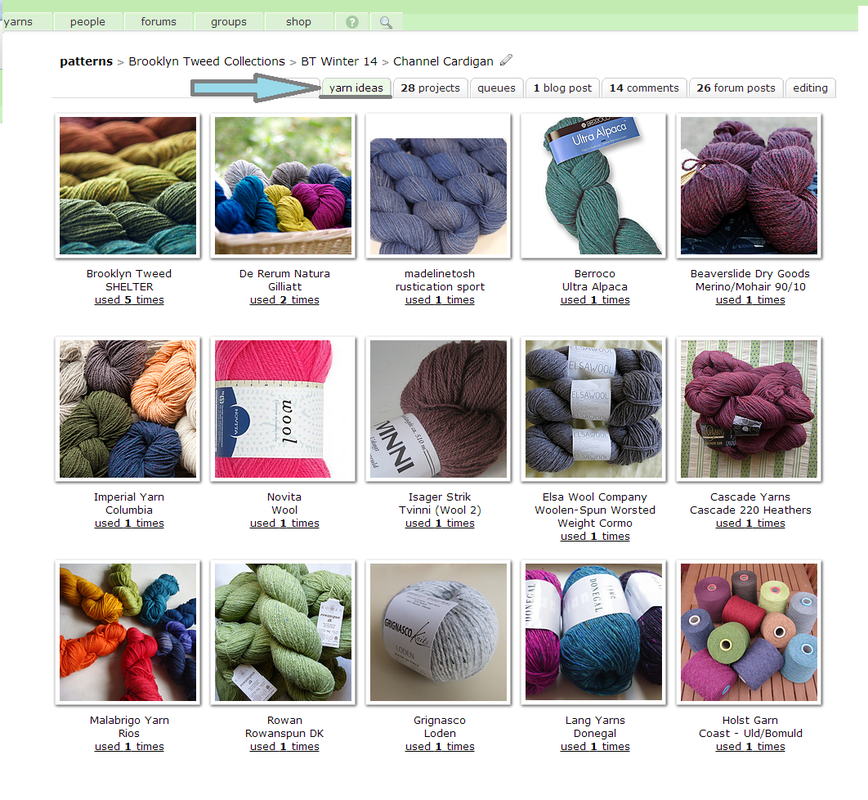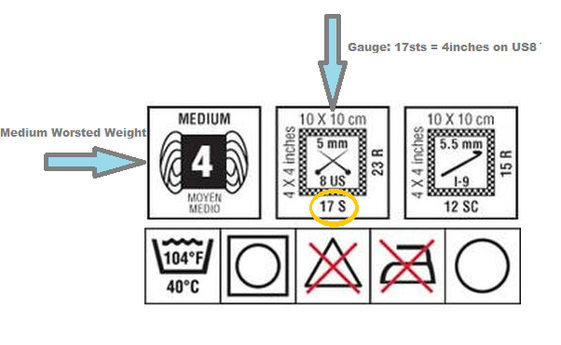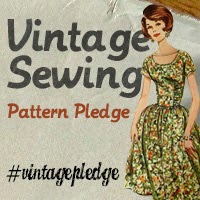|
Almost equally important to choosing the correct pattern size is choosing the correct type of yarn to knit with. When you consult your pattern, you'll note that the author tells you, very specifically, that you need worsted weight wool yarn. This description provides two important pieces of information: yarn weight and fiber content. Let's start with fiber content. The sample shown on the Channel Cardigan Pattern Page is knit from Brooklyn Tweed Shelter, a 100% American Targhee-Columbia wool. While it's not essential to knit this sweater using the same yarn as the author, it is important to choose a yarn with similar properties to the type of yarn the author has chosen in order to achieve a similar result. I don't know a knitter who doesn't love alpaca, but choosing alpaca yarn for a project like this wouldn't be a great yarn choice. Why? Well, to start, the Channel Cardigan is a heavily textured design that requires good stitch definition in order to accentuate the details of the patterns incorporated. Fabric knit from alpaca has a halo, which will "swallow" all the details of your stitch patterns. Also, this pattern, though knit with positive ease, has a fair amount of structure, and fabric knit from alpaca doesn't. In fact, it produces the opposite effect- drape. For those of you who sew, it would be like expecting the same result from garments sewn using woven cotton and charmeuse. Many number of other fibers are equally inappropriate for this design. (NOTE: Clara Parkes' The Knitter's Book of Wool and The Knitter's Book of Yarn are wonderful resources for those interested in learning about fiber characteristics.) As a general rule of thumb, the fuzzier/fluffier a yarn is, the poorer the stitch definition will be. And, inversely, smooth, tightly spun yarns will produce better stitch definition. For optimal pattern enhancement, I recommend sticking with either a 100% wool yarn or a blend that is predominantly wool. One way to help make a decision about which variety of yarn to use is to look and see which types of yarn other knitters have used and the results they produced using those varieties. To do this select the "yarn ideas" tab from the Channel Cardigan pattern page on Ravelry. You can then see how these yarns work with the Channel Cardigan pattern by following the "used 'x' times" link below the yarn. Another way to find yarn is using the filters on Ravelry's yarn search. Using the fiber filter for wool and the weight filter for worsted yarns, you can see more than 4,000 different types of wool and wool blend yarn for consideration. You can arrange the search results to see which yarns have been used on the most projects, have the highest rating, or are the best match for the filters you applied. You can also view projects knit with each yarn to determine whether or not that yarn produces a fabric that would be well suited to the pattern. Of course, nothing beats getting up-close-and-personal with yarns at your LYS. Many shops have swatches knit and on display throughout the store to help shoppers get a better understanding for the fabrics each yarn produces. Don't be afraid to touch. Handling swatches will help you understand the properties of the fabric: does it lay nicely over contours? Does it have nice rebound? How is the stitch definition? Etc... Now, on to our second piece of information, yarn weight. While you are shopping for yarn, it is important to realize that not all worsted weight yarns are created equally. Yarn weight is a standardized system created as a guideline. And, as with most systems that generalize or standardize, there is typically some level of standard deviation between manufacturers. In order to better understand your specific yarn, you can refer to the label for gauge information.
Many yarn labels will provide you with visual gauge information, similar to that shown in the image above. Using these symbols, we know that the yarn packaged within the wrapper is a Medium worsted yarn. The symbol '4' stands as representation for this weight category, and it is a quick reference. The next symbol tells us that we should be able to expect a gauge of 17sts. over 4 inches (or 4.25 sts. per inch) when knitting with a US 8 needle. Shelter has gauge of: 18 sts = 4 inches on US 8 needle (or 4.5 sts. per inch). If you plan to substitute a medium weight worsted yarn in place of Shelter, it is VERY IMPORTANT to accommodate for this disparity in gauge. Over the span of an entire sweater, those fractions of a stitch add up and make a drastic difference. Additional factors, including your personal knitting tension, will play a role in the gauge you achieve from a particular yarn. The absolute best way to know how your yarn will behave with the pattern is to SWATCH! Which, is exactly what we'll do next week! As a final note, when purchasing yarn for a pattern, it is ALWAYS better to err on the side of caution (ask me how I know). Too much yarn is better than not enough!
6 Comments
Wow, this is a really helpful post for a new knitter! I had no idea that I should consider things other than gauge when choosing yarn. I just started knitting my first cardigan (the Miette) and just went with the yarn the pattern recommended because I just wanted things to be as simple as possible, but I considered a lot of different yarns when I went to the store. I'm glad I decided to stick with Cascade Sierra because I don't know that I would have chosen a yarn with similar properties. The Cascade Sierra seemed like a good blend of cotton and wool that wouldn't make me itchy, but I'm going to have to research to find good substitutes for 100% wool yarn because it will certainly make me itchy.
Reply
It is always a safe bet to use the same yarn the pattern calls for! You know exactly what you're getting when you go that route!
Reply
2/11/2014 06:46:03 am
Just saw this post and the channel KAL, got to get on it!
Reply
Leave a Reply. |
Archives
March 2017
|






